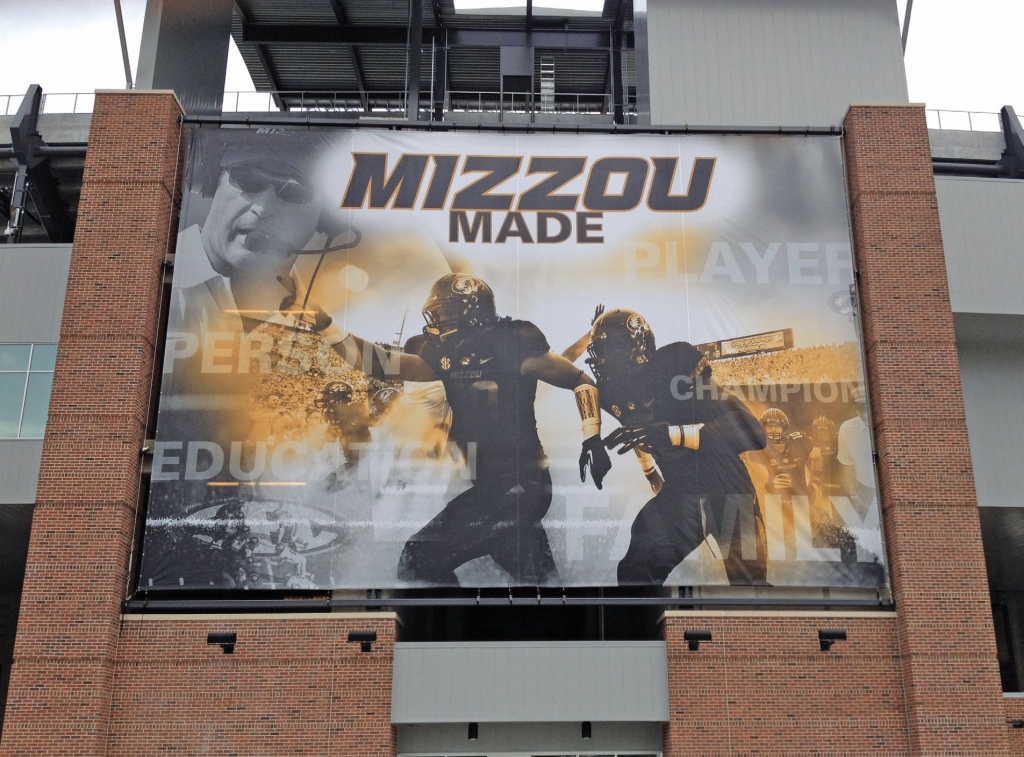Since joining the SEC in 2012, the Univ. of Missouri’s football program has undergone a Pygmalion-like transformation. With the exception of Dan Devine’s 1960s coaching tenure, “Mizzou” was largely mediocre on the gridiron until Gary Pinkel took the reins in 2001 and gradually built the Tigers into a Big 12 and SEC contender. When the school joined the SEC, skeptics thought a decade might pass before the Tigers would contend in football. Yet, in its second and third seasons, the school claimed SEC Eastern Division titles.
School officials deemed the school’s rising gridiron profile as an appropriate time to upgrade signage and environmental graphics during a renovation of its stadium, Faurot Field. In 2014, the school hired Toledo, OH-based Harmon Sign to fabricate the sign package. Nelson Pixler, Harmon’s national sales manager, said stadia and arenas represent approximately 10% of the company’s work. Pixler said Harmon Sign keeps close tabs on stadium-renovation and construction happenings nationwide, and has earned prequalification on a select-bid list.
Harmon’s John Venglarcik, the company’s national sales executive, said the shop wanted the job “more than most” because of a personal connection. Missouri’s head coach, Gary Pinkel, had formerly coached at the Univ. of Toledo, and his daughter, Erin, remained in Toledo and worked as a Harmon sales rep for approximately 18 months.
“Stadium work is unique because there’s no deadline flexibility – the season starts when it starts,” Venglarcik said. “They also have unique, project-management requirements because so much coordination is required with other trades – electrical and structural engineering, plumbing, etc. All site conditions must be accounted for throughout construction.”
All told, the Missouri project entails 582 signs that encompass 11,058 sq. ft. Harmon was able to survey half the stadium, and was installing signs concurrent with Faurot’s renovation.
For the Tiger logo installed within the main exterior concourse, Harmon fabricated an overlay that comprises 0.125-in.-thick, brushed, CNC-routed aluminum secured over a ¼-in.-thick, aluminum plate, lined with metal studs and bonded with epoxy. Aluminum angle, 1.25 x 1.25 in., was secured with the studs and affixed to square tubes attached to the gate. Installing the panels required a bucket lift and a Gradall rough-terrain wheeled vehicle to navigate the site while it was under construction.
To execute the “Mizzou Made” 53 x 35-ft. panels on either side of the stadium, Harmon Sign partnered with CGS Imaging, a Maumee, OH-based service provider. CGS printed the panels, which comprise tight-weave, mesh fabric, on a 5m-wide EFI-VUTEk G5500LXR Pro LED-cure printer with 3M’s Superflex UV inks. Harmon mounted the scrims on 6 x 6 x ½-in., square-steel tubing with 3,000-lb.-capacity ratchet straps, and 1/8-in.-diameter, aircraft cable runs from top to bottom through eyebolts.
Overhead wayfinding signs help black-and-gold-clad fans locate their seats. They comprise 0.080-in.-thick, mill-sheet aluminum decorated with Matthews acrylic-polyurethane paint, with an inset digital print and a laser-etched, infilled logo. A freestanding stadium map was built with a 4 x 4-ft., aluminum-tube-frame foundation with a 1-in., square-tube build-out; a 0.063-in.-thick, aluminum face and, like the overhead signs, an inkjet-printed graphic and etched logo.
According to Dennis Voss, Harmon’s project manager, the biggest challenge involved the two wall signs on the stadium’s club level. They feature four different levels, with recessing and protruding areas. The 41-ft.-4-in.-long environmental graphic features a combination of inkjet-printed and flat, cut-out-letters.
“The sign stands at eye level, with seating below. So, the designer wanted to use the MDF board to make the sign appear substantial if someone approached or bumped into it,” Voss said. “We created a sturdy frame to hold the MDF’s weight, because we couldn’t sit it directly on the floor. We had a 35-in. space underneath where the benches are located. Because the sections were so heavy, we lifted them into place with a crane. It was also a challenge to obtain the required glossy finish on the MDF. We epoxy-coated the board, sanded it, applied white, glossy paint, and then repeated the sections.”
Pixler continued, “Of course, the schedule was tight. That’s expected with stadiums. We had a ten-week window from the approval of designs until Missouri played its first home game.”



 Tip Sheet1 week ago
Tip Sheet1 week ago
 Ask Signs of the Times3 days ago
Ask Signs of the Times3 days ago
 Real Deal1 week ago
Real Deal1 week ago
 Benchmarks5 days ago
Benchmarks5 days ago
 Editor's Note2 weeks ago
Editor's Note2 weeks ago
 Photo Gallery21 hours ago
Photo Gallery21 hours ago
 Women in Signs1 week ago
Women in Signs1 week ago
 Photo Gallery1 week ago
Photo Gallery1 week ago







